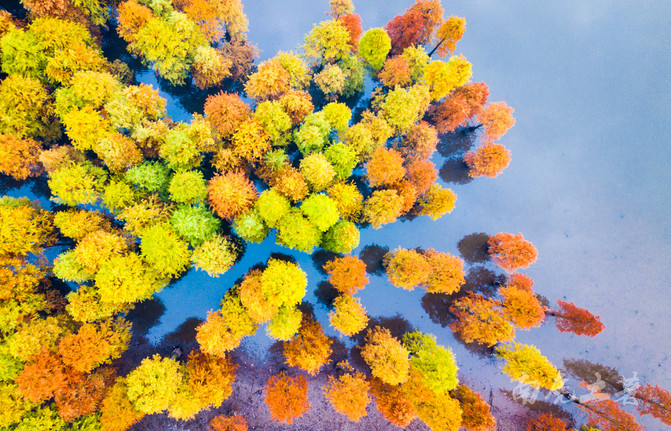A niche tourist destination that Nanjing has never heard of, Metasequoia is as bright as fireworks in autumn

Every year in autumn, I think of metasequoia, and the golden color on the clear water always comes to mind. I have inquired about many metasequoia lands. The relatively large ones around Hangzhou include Linhai Metasequoia, Qingshan Lake Metasequoia, and Ningguo Metasequoia. However, either the journey cannot be separated, or the time to get there is missed.

Coming down from Qixia Mountain in Nanjing, I estimated that the metasequoia would turn yellow. After crossing the Yangtze River, I took a break in Zhu Town, Liuhe District. We set off early the next morning after the rain and headed to Zhimaling in the northwest direction. Zhimaling is also known as Zhima Ridge. It is the boundary mountain between Jiangsu and Anhui provinces. There are about 10,000 acres of forest land here. The mountains are quiet and the dense vegetation has become colorful. Colorful, smoke is lingering after the rain, giving a pristine scenery.

Less than 500 meters up the mountain from the parking lot is a reservoir called Daquan. The shrinking water level in autumn makes the reservoir small, making it very quiet in the hazy morning fog. There is a metasequoia forest on one side near the mountain. It can be seen from the watermarks on the lower section of the trunk that the water level here is more than one meter higher at its highest.

Local villagers said that this red cedar was planted in the 1960s. At that time, drainage technology was not developed. The terrain here was low-lying and accumulated water every year. Only water-resistant metasequoia could be planted. Later, a reservoir was simply built. Over time, the red cedar planted that year has become a forest in the water, becoming today's wonder.

Every year in autumn, the leaves of the Metasequoia forest begin to turn yellow one after another, and then turn red. Each tree has its own time, so it becomes green, yellow, and red, with colorful colors, becoming an autumn attraction for surrounding tourists. It is known as the "Nanjing Little Jiuzhaigou". Tourists from far away may not arrive here alone, but if they drop by, they will add a lot of color to the journey.

The wonderful thing is that from another angle, looking down from a high place, the scene is completely different. The clouds in the sky are floating on the water, and the woods are like blooming flowers, dotted with clear water, like fireworks blooming in the night sky, dazzling and charming.

Of course, you can also climb to the height of the mountain and look at it. Maybe the angle is not like this, or maybe there is another scene.

At this moment, the sun broke through the clouds and mist and sprinkled in a brief light. Tree trunks were lined up and printed upside down in the water. The base of the tree trunks was expanded and the vertical ridges were thick and wild, outlining the beauty of the lines of nature, like soldiers standing tall in the autumn wind. Year after year, standing into a scenery.

Suddenly I remembered the famous poem "To the Oak Tree" written by Shu Ting, one of the representative figures of the hazy poetry school in his early years:
"I must be a kapok tree near you, standing with you as the image of a tree. The roots are tightly grasped in the ground, and the leaves are touching in the clouds. With every gust of wind, we greeted each other, but no one understood our words. You have your copper branches and iron trunks, like knives, swords, and halberds; I have my red flowers, like heavy sighs and heroic torches."

It is said that Metasequoia is a rare relic plant in the world. Back in the Cretaceous of the Mesozoic, Metasequoia plants had appeared on the earth and were widely distributed in the northern hemisphere. After the Ice Age, almost all of these plants disappeared. What is amazing is that in the 1940s, Chinese botanists discovered the surviving giant Metasequoia tree in Modaoxi at the junction of Hubei and Sichuan. It was about 400 years old. Later, it was discovered in Hubei and Hunan. Big trees were discovered. Today, the dinosaurs are gone and have become fossils, but the metasequoia still exists. They are veritable living fossils.

Metasequoia are mostly found in places near valleys or foothills with gentle terrain, deep soil layers, moist or stagnant water, and have strong water resistance. Nowadays, the Metasequoia forest lands in the Jiangnan area are probably gradually propagated after these ancient tree species were discovered. Because people have mastered the propagation technology of Metasequoia, or used hardwood and twig cuttings.

It is said that there are also thousand-year-old yellow trees, century-old chestnut forests, and the ruins of "Longquan Temple" and "Guangfo Temple" on Zhimaling Mountain. I have traveled in a hurry and I will only come back next time. Before leaving, a group of girls were jubilant on the water bank, backed by the colorful forest, facing the clear water, and breathing deeply into the fresh air of nature.
Previous Article:Nanjing People Look at Nanjing--The Academy of Agricultural Sciences in Spring
Next Article:Nanjing--Take your dreams back to Jinling and dream old dreams of the Republic of China
